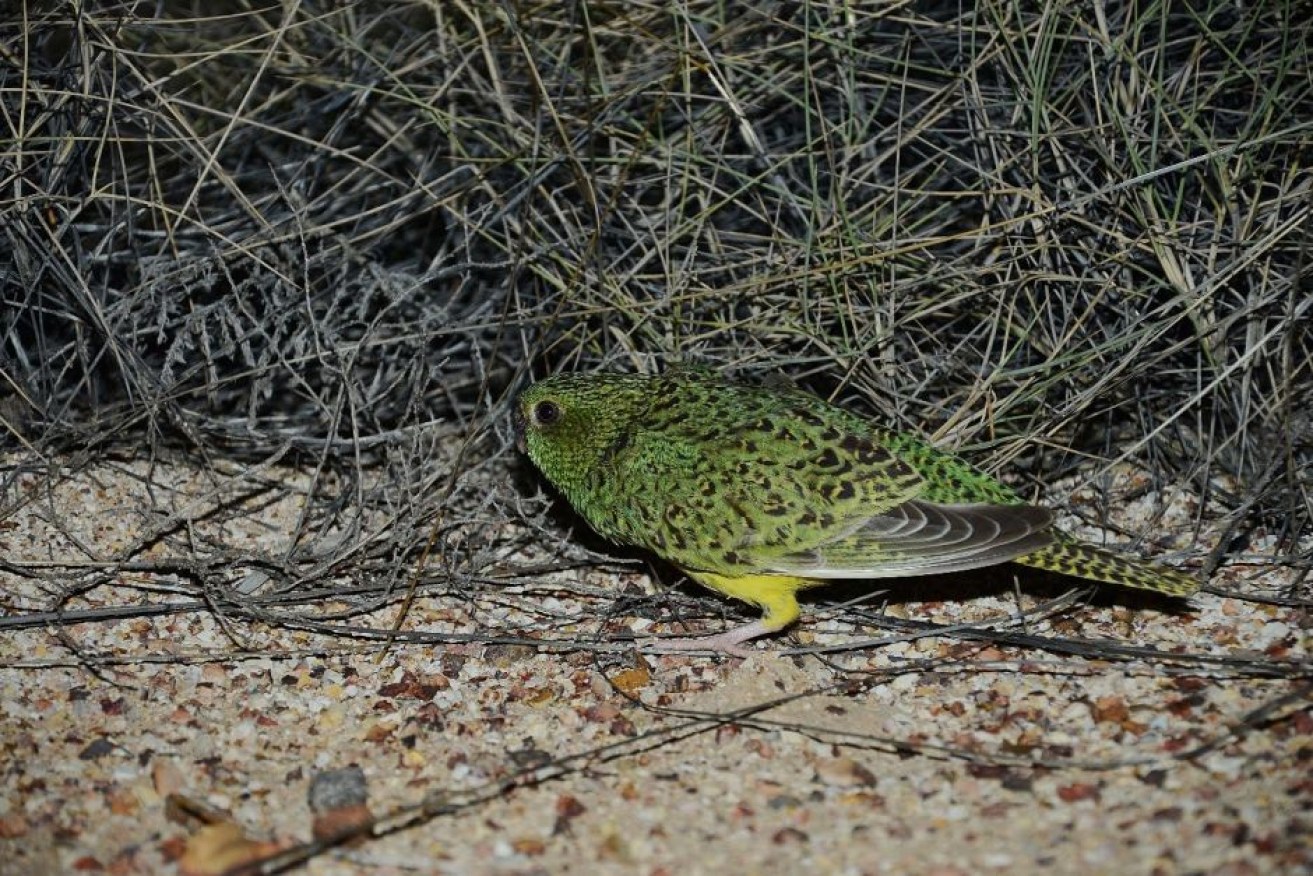‘More fake news’: Experts slam dubious night parrot research after release of damning report

John Young's photo of a night parrot in western Queensland in 2013 has come under scrutiny for the methods employed to capture it. Photo: Supplied/John Young
When John Young claimed in 2013 to have found the elusive night parrot, which had not been seen in more than a century, he became a hero among bird watchers.
But the charismatic naturalist’s reputation is now in tatters with an independent panel of experts criticising the veracity of some of his latest research.
It is a major embarrassment for the Australian Wildlife Conservancy (AWC), which published a number of reports based on Mr Young’s fieldwork.
The non-profit organisation also used his controversial photographs in fundraising material to attract donations from the public.
“Due to the findings, AWC is retracting records of the night parrot published by AWC,” chief executive officer Tim Allard said in a statement on Friday.
“The methods used in this work were not consistent with AWC’s usual procedures.”
Mr Young’s initial discovery of the night parrot was genuine, made international headlines, and transformed him into a minor celebrity.
As a result of his efforts, Bush Heritage bought 56,000 hectares of land where the bird was sighted in order to protect the population.
But Mr Young’s subsequent fieldwork raised eyebrows with a handful of shrewd observers pointing out inconsistencies.
While employed as a senior ecologist with the AWC, Mr Young was said to have recorded the sound of a night parrot in South Australia’s Kalamurina Wildlife Sanctuary.
He found a feather in that same location and, during a visit to Queensland’s Diamantina National Park, photographed eggs allegedly belonging to the bird.
But the independent panel hired by the AWC to scrutinise Mr Young’s work has called into question each of these assertions.
The panel, made up of four eminent ornithologists and conservation scientists, found there was no reliable evidence to support the claim Mr Young had recorded the call of the night parrot.
The audio only contained archival sound of the bird Mr Young was playing through a speaker in an effort to attract the creature to where he was positioned in the field.
The feather he came across in a zebra finch nest turned out to be entirely different to the one later given to the South Australian Museum for safekeeping, the panel said.
Even some of the eggs were deemed by a majority of the panel to be fake
“On the balance of probabilities and the evidence available, the eggs in the photograph were artificial eggs,” Mr Allard told Background Briefing and ABC Science.
“You’d have to ask the individual in question as to why he did that.”
The panel’s damning report effectively erases all confirmed sightings of the night parrot on land owned by the AWC.
Conservationists fear huge credibility hit

Old preserved specimens of night parrot (on left) are still used to study the bird’s physiology. Photo: Supplied/Michael Kearney
Bird enthusiasts have been left feeling deflated but the impact on the scientific community is arguably more serious, with precious conservation funding on the line.
“It’s just more fake news,” said Professor Penny Olsen from the Australian National University.
“It’s deceptive, unscientific, and downright damaging.”
Professor Olsen said Mr Young’s falsified research would harm the AWC’s credibility and future fundraising efforts.
“It’s deceiving donors and grant givers by misusing the scarce conservation dollar,” she said.
“So little in this country goes towards conservation and you want it to go in the right direction.”
The AWC, now one of the biggest landowners in Australia, buys large swathes of habitat to create sanctuaries for a variety of threatened species.
Ecologist Dr Stephen Murphy fears the night parrot scandal will undo all the good work the organisation has been doing.
“That would be an absolute injustice,” Dr Murphy told Background Briefing.
“To have that mission jeopardized by this one-off, isolated incident would be a real shame.”
Dr Murphy said the AWC will have to work hard to rebuild trust.
“Without scientific integrity, we’ve got nothing,” he said.
“Scientific integrity is the thing that underpins humanity.”

The night parrot was previously thought to be extinct in WA. Photo: Supplied/ Bruce Greatwich
John Young deflects report’s criticism
The AWC said it had already adopted all of the independent panel’s recommendations for improving protocols and procedures.
They include recording GPS data on photographs, referral of rare bird records to BirdLife Australia’s rarities committee, and having data verified by independent experts.
But Dr Murphy said the organisation’s biggest mistake was believing his former colleague.
“If the AWC is guilty of anything, it’s trusting John Young.”
Mr Young denies any wrongdoing but would not respond to specific questions about the controversy, dismissing them with a “no comment”.
“I have no interest in any criticism,” he told Background Briefing.
Reflecting on the negative publicity surrounding his research, Mr Young said he contemplated giving up his work.
“I wanted to walk away from conservation, I wanted to walk away from everything,” he said.
“I wish I’d never saw it, wish I’d never found it, wish I’d never had to do it.
“It’s been a nightmare but I’ve come through it.”
Federal government spending on conservation is going down. Just last year, staff at the environment department were cut by a third.
If the current rates of funding continue, with no further cuts, Australia’s Threatened Species Recovery Hub said 17 unique Australian birds and mammals would be forced into extinction in the next 20 years.
For this reason and others Mr Young has vowed to continue to advocate for conservation.
“It’s not fair on those good people who want to do good things,” he said.
“I would be letting them down and more to the point I’d be letting the animals and the birds down.
“I won’t do that. I’ll die doing stuff.”
–ABC








